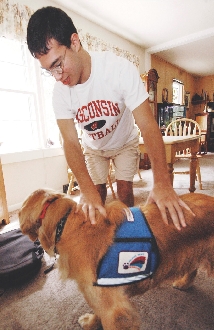How Dogs Help
Imagine if you couldn’t turn on a light or open the refrigerator. Life might be pretty frustrating. You’d have to have dependable people around you all the time. Or would you?
Some people with physical disabilities rely on special dogs. These animals provide a service and give their owners a welcome sense of independence. They do this by helping with daily activities.
The best known service dogs are guides for the visually impaired. But four-legged friends perform other roles, too. One group called Canine Companions for Independence trains dogs to open and close doors. They also train them to switch lights on and off and pick up dropped objects. They can even train dogs to pull wheelchairs.

Andrew Brenes has cerebral palsy. He uses his service dog, Tonka, to regain balance.
Making Life Better
Service dogs can also help others to better understand people with disabilities. That’s what happened for a girl named Megan. Megan is seven. She has a medical condition called Angelman syndrome. She can’t speak or walk. People felt uncomfortable around Megan when she was younger. Megan was lonely.
Things changed when Gabri came along. The two-year-old Labrador retriever became Megan’s furry friend. “Gabri is the perfect icebreaker,” says her mother. “People who didn’t know what to say before come right up and ask about Megan’s dog.”
Megan gets help to feed and brush Gabri. “If this dog makes Megan’s life a tiny bit more fun, then it’s worth it.”